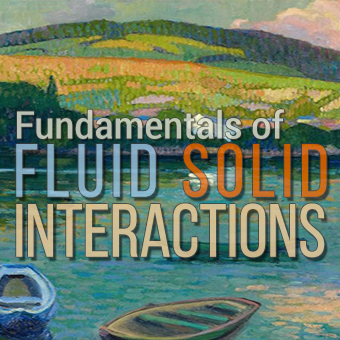- Home
- Catalog
- Online Course
- FUNDAMENTALS OF FLUID-SOLID INTERACTIONS
FUNDAMENTALS OF FLUID-SOLID INTERACTIONS
Start
11/11/2019
Duration
6 weeks
Rhythm
3-4 hour per week
Prerequisites
Fundamentals of fluid mechanics and solid/structural mechanics are required. A knowledge in structural dynamics and vibration can be helpful, but is not required. On demand course.
Discipline
Mecanics
Course language
English

PRESENTATION:
Fluid-Solid Interactions happen when the motion of solids and fluids are coupled. The aim of the course is to give you the basic tools to be able to understand, predict and eventually mitigate these interactions.
ABOUT THE COURSE
What is fluid-solid interactions ? It is what happens when the motions of a fluid and of a solid are somehow coupled. This happens all the time, around you when leaves flutter in the wind, inside you when your heart beats, above you when wings of a plane vibrate, under the sea.
The idea behind this MOOC is to give you the basic tools to be able to predict and eventually mitigate things called flutter, galloping, sloshing, vortex-induced vibrations, added mass, to cite a few.
We are going to consider any possible domains of applications such as civil engineering, aerospace engineering, nuclear engineering , ocean engineering, biomechanics and even food processing !
This is why we called the course “fundamentals of Fluid solid interactions ”. There are so many phenomena and so many models that we need to work together on the basic mechanisms .
If you want to see how fluid-solid interactions work, and be able to use that knowledge, join us !
COURSE SYLLABUS
Dimensional analysis of fluid-solid coupling
The variety of fluid-solid couplings
Dimensional analysis as a classification tool
Dimensionless numbers in fluid-solid interactions
From dimensionless numbers to dimensionless equations
A solid with a still fluid.
Low reduced velocities
Small motions and low reduced velocities
Fluid-added Stiffness
Neglecting viscous effects
Fluid-added mass.
A solid with any fluid.
Dominant effects of viscosity
Fluid-added damping
Combined effects of fluid viscosity
Memory effects
Fluid sloshing
Coupling of fluid sloshing with solid dynamics
Coupling with a fast flow.
High reduced velocities
Flow-induced static instabilities, or buckling
Coupled-mode flutter of airfoils.
Coupling with a slow flow.
Intermediate reduced velocities
Flutter on one mode
Stall flutter of airfoils
Galloping of bluff bodies
Coupling with any flow.
The fluid conveying pipe as a reference model of coupling
Coriolis damping
Solution for any flow velocity
From one mode to two modes
Vortex-induced vibrations
Lock-in as a case of coupled-mode flutter
SUGGESTED READINGS
The lecture are self-contained, but the students will find useful additional information in the following book in paperback : Païdoussis, M. P., Price, S. J., & de Langre, E. (2011). Fluid-structure interactions: Cross-flow-induced instabilities Cambridge University Press.
A textbook in French also contains material closely related to the content of the course de Langre, E. (2002). Fluides et solides. Editions Ecole Polytechnique.
Teacher(s)


